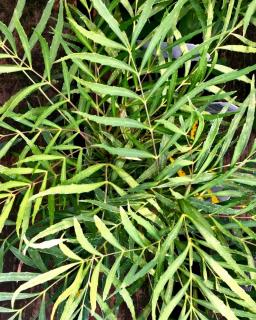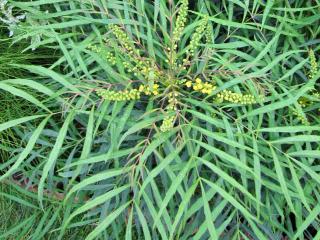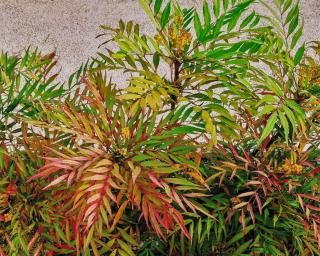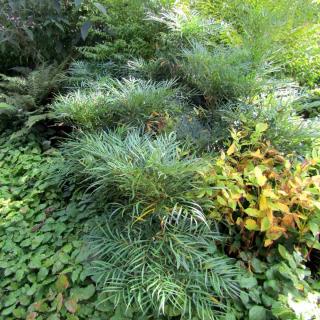

With surprising bamboo-like leafage, the Mahonia ‘Soft Caress’ is a shrub that will make you feel in the Far East.
Mahonia ‘Soft Caress’ key facts
Name – M. eurybracteata ‘Soft Caress’
Family – Barberry family
Type – sub-shrub, evergreen
Height – up to 3 feet tall, 5 wide (1m x 1.5m)
Exposure – part sun or shade
Soil: ordinary to rich – Blooming: fall – Harvest: spring (berries)
It’s also a very stylish plant with graphical leafage that will do great in modern designer gardens.
Read also:
 Usually, Mahonia ‘Soft Caress’ is sold in pots.
Usually, Mahonia ‘Soft Caress’ is sold in pots.
Follow these guidelines on planting a shrub.
Where to plant your Soft Caress:
It grows best in shade or part shade, so you can plant it in the following situations:
Unlike other mahonias, this hybrid can still thrive even if drainage isn’t optimal.
Watering and pruning are the two tasks you’ll need to care for your mahonia well.
Apart from the first year, when the plant is still working on spreading its roots out, you won’t need to water your soft caress very often.
You can also cut the need to water over all with hydrocrystals. These are mixed in with the soil upon planting in tiny amounts, but for five years they’ll regulate water and help the plant grow without any need to water at all.
It doesn’t require much fertilizer. Simply using mulch will both help keep the ground cool and break down into useful nutrients.
 There usually isn’t any need to prune the plant, since it stays smallish even when mature. It’ll rarely grow any taller than 1 yard or meter.
There usually isn’t any need to prune the plant, since it stays smallish even when mature. It’ll rarely grow any taller than 1 yard or meter.
If it grows to more that 1 yard or meter wide, it means new shoots are growing from the roots or from fresh new seedlings.
Since it’s a slow grower, it’s easy to keep under control. If you do need to “shrink” it, spring is the time to do it.
 This shrub is quite hardy, coping well with cold weather dropping down to 14-15°F (-10°C).
This shrub is quite hardy, coping well with cold weather dropping down to 14-15°F (-10°C).
You can protect it in winter if it gets any colder. It’s normal for leaves to turn red when the cold gets too harsh. New, green leaves will grow back in spring.
It will help to spread mulch at the foot of your Soft Caress so that the soil doesn’t dry out.
There aren’t many diseases or pests that will attack your plant.
Even though there aren’t any spikes, deer aren’t very fond of the plant.
‘Soft Caress’ is a variety protected by a plant patent (#PP20183). This means it’s not allowed to propagate and sell the plant without permission from the patent holder.
If your shrub is dying you can snip a branch off and propagate that so it can survive.
Note that for cuttings, best is to select stems at the end of summer.
When layering or marcotting, remember to stake the branch you’re working. On Soft Caress, they aren’t as strong and might break before the marcot is ready.
If you’re willing to risk growing a plant that will probably be slightly different, however, you can recover seeds from your Soft Caress and plant those!
This Mahonia will send out shoots from the root crown. It’s possible to split the plant clump with a sharp spade.
In summer, leaves of the ‘Soft Caress’ are aptly named: they sway with the breeze in a soft and fragrant way. They’re long and thin, much like those of bamboo.
 Unlike common Mahonia, this shrub doesn’t have any spikes or thorns, whether on the stems or on the leaves.
Unlike common Mahonia, this shrub doesn’t have any spikes or thorns, whether on the stems or on the leaves.
The deep, olive-green color of the leaves contrast magnificently with the gold yellow blooming, a heart-warming sight during drab fall and winter days. With mild to cold weather, blooming will last up to three weeks.
It’s perfectly possible to eat the berries that form afterwards: ‘Soft Caress’ berries are edible, for instance in the form of Mahonia berry jam. You can even eat them raw, although there are a few precautions to note.
The foliage is evergreen, meaning it will stay on the plant over winter. Come spring, older fronds die out and are replaced with newer ones.
The mother species of this special cultivar is Mahonia eurybracteata, with full name Mahonia eurybracteata subspecies ganpanensis.
Although the wild species has many of the same characteristics, the one commonly found in garden centers is the ‘Soft Caress’ variety.
Plant Soft Caress in pots or planters, it will do great on a deck, terrace or patio!